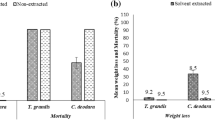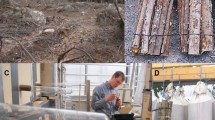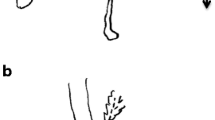Abstract
We tested how terpenoid (i.e., monoterpenes and resin acids) composition and concentration in wood affects resistance against wood-borers and decaying fungi. Scots pine (Pinus sylvestris) wood from nine provenances having variable terpenoid profiles was studied against the old house borer, Hylotrupes bajulus, and the decay fungus, Coniophora puteana. Provenances represented a 1200-km N–S transect from Estonia to northern Finland, but they were all cultivated for 7 years in the same nursery field, in central Finland. Mean relative growth rate (MRGR) of small H. bajulus larvae positively correlated with the total monoterpene concentration of wood, and feeding was associated with high proportion of levopimaric+palustric acid in wood. Provenance did not affect the MRGR of small or big larvae, but big larvae consumed more wood and produced more frass on the northern Ylitornio trees than on the southern Rakvere and Ruokolahti trees. Low β-pinene and total monoterpene concentration and low β: α-pinene ratio in wood were all associated with a high number of eggs. The most northern Muonio provenance was the most favored as an oviposition site, differing significantly from Saaremaa, Tenhola, and Suomussalmi. Wood from Saaremaa, Tenhola, Ruokolahti, and Suomussalmi provenance was most resistant against decay fungus, differing significantly from that of Kinnula provenance. However, decay resistance was not clearly associated with the concentrations of wood terpenoids. These results suggest that monoterpene composition of wood affects resistance against wood-boring Cerambycid beetles, but resistance against wood-decaying fungi is not as clearly associated with wood terpenoids.
Similar content being viewed by others
References
Baradat,P. H. and Yazdani,R. 1988. Genetic expression for monoterpenes in clones of Pinus sylvestris grown on different sites. Scand. J. For. Res. 3:25-36.
Berry,R. W. 1972. A rearing procedure for the house longhorn beetle Hylotrupes bajulus L. Int. Biodetn. Bull. 8:141-144.
Beuker,E. 1994. Long-term effects of temperature on the wood production of Pinus sylvestris L. and Picea abies (L.) Karst. in old provenance experiments. Scand. J. For. Res. 9:34-45.
Cannon,K. F. and Robinson,W. M. H. 1981. Wood consumption and growth of Hylotrupes bajulus (L.) larvae in three environments. Environ. Entomol. 10:458-461.
Eberhardt,T. L., Han,J. S., Micales,J. A., and Young,R. A. 1994. Decay resistance in conifer seed cones: Role of resin acids as inhibitors of decomposition by white-rot fungi. Holzforschung 48:278-284.
European Standard EN 47. 1988. Wood preservatives; Determination of the toxic values against larvae of Hylotrupes bajulus (Linnaeus) (Laboratory method). European Committee for Standardization, Brussels
Fettköther,R., Reddy,G. V. P., Noldt,U., and Dettner,K. 2000. Effect of host and larval frass volatiles on behavioural response of the old house borer, Hylotrupes bajulus (L.) (Coleoptera: Cerambycidae), in a wind tunnel bioassay. Chemoecology 10:1-10.
Flodin,K. and Fries,N. 1978. Studies on volatile compounds from Pinus sylvestris and their effect on wood-decomposing fungi. II: Effects of some volatile compounds on fungal growth. Eur. J. For. Path. 8:300-310.
Fries,A., Ericsson,T., and Gref,R. 2000. High heritability of wood extractives in Pinus sylvestris progeny tests. Can. J. For. Res. 30:1707-1713.
Gershenzon,J. and Croteau,R. 1991. Terpenoids, pp. 165-219, in G. A. Rosenthal and M. R. Berenbaum (eds.). Herbivores. Their Interactions with Secondary Plant Metabolites, Vol. 1: The Chemical Participants. Academic Press, New York.
Graf,E. VON, Manser,P., and Schmitter,M. 1989. Einfluss der Vitalität von Fichten (Picea abies (L.) Karst.) und Tannen (Abies alba) auf die Resistenz des Bauholzes gegen Eilarven des Hausbockes (Hylotrupes bajulus L.). Mater. Org. 24:93-106.
Gref,R. 1987. Resin acids and resistance of Pinus sylvestris to Melampsora pinitorqua. Eur. J. For. Path. 17:227-230.
Gref,R. and Ericsson,A. 1985. Wound-induced changes of resin acid concentrations in living bark of Scots pine seedlings. Can. J. For. Res. 15:92-96.
Hanks,L. M. 1999. Influence of the larval host plant on reproductive strategies of cerambycid beetles. Annu. Rev. Entomol. 44:483-505.
Harju,A. M., Kainulainen,P., Venäläinen,M., Tiitta,M., and Viitanen,H. 2002. Differences in resin acid concentration between brown-rot resistant and susceptible Scots pine heartwood. Holzforschung 56:479-486.
Harju,A. M., Venäläinen,M., Beuker,E., Velling,P., and Viitanen,H. 2001. Genetic variation in the decay resistance of Scots pine wood against brown rot fungus. Can. J. For. Res. 31:1244-1249.
Hart,J. H. and Shrimpton,D. M. 1979. Role of stilbenes in resistance of wood to decay. Phytopathology 69:1138-1143.
Hart,J. H., Wardell,J. F., and Hemingway,R. W. 1975. Formation of oleoresin and lignans in sapwood of white spruce in response to wounding. Phytopathology 65:412-417.
Henriks,M.-L., Ekman,R., and Weissenberg,K. VON. 1979. Bioassay of some resin acid and fatty acid with Fomes annosus. Acta Acad. Aboensis, Ser. B 39:1-7.
Higgs,M. D. and Evans,D. A. 1978. Chemical mediators in the oviposition behaviour of the house longhorn beetle, Hylotrupes bajulus. Experientia 34:46-47.
Hiltunen,R., Tigerstedt,P. M. A., Juvonen,S., and Pohjola,J. 1975. Inheritance of 3-carene quantity in Pinus silvestris L. Farm. Aikak. 84:69-72.
Holm,C. and Ekbom,P. 1958. The significance of the house longhorn beetle as a destroyer of buildings and its control. The State Institute for Technical Research, Series III—Building, pp. 1-44, Helsinki.
Hrutfiord,B. F. and Gara,R. I. 1989. The terpene complement of slow and fast growing Sitka spruce terminals as related to Pissodes strobi (Peck) (Col., Curculionidae) host selection. J. Appl. Entomol. 108:21-23.
Langenheim,J. H. 1994. Higher plant terpenoids: A phytocentric overview of their ecological roles. J. Chem. Ecol. 20:1223-1280.
Ljungkvist,H. 1983. Hylotrupes bajulus occurring in natural habitat (Col. Cerambycidae). Entomologisk Tidskrift 104:35.
Manninen,A.-M., Tarhanen,S., Vuorinen,M., and Kainulainen,P. 2002. Comparing the variation of needle and wood terpenoids in Scots pine provenances. J. Chem. Ecol. 28:211-228.
Manninen,A.-M., Vuorinen,M., and Holopainen,J. K. 1998. Variation in growth, chemical defense, and herbivore resistance in Scots pine provenances. J. Chem. Ecol. 24:1315-1331.
Mares,J. T., Pospischil,R., and Robinson,W. H. 1986. Structure and function of the ovipositor of Hylotrupes bajulus (L.) (Coleoptera: Cerambycidae). Mater. Org. 21:15-30.
Micales,J. A., Han,J. S., Davis,J. L., and Young,R. A. 1994. Chemical composition and fungitoxic activities of pine cone extractives, pp. 317-332, in G. C. Llewellyn, W. V. Dashek, and C. E. O'rear (eds.). Biodeterioration Research 4. Mycotoxins, Wood Decay, Plant Stress, Biocorrosion, and General Biodeterioration. Plenum Press, New York.
Mowe,G., King,B., and Senn,S. J. 1983. Tropic responses of fungi to wood volatiles. J. Gen. Microbiol. 129:779-784.
Nerg,A., Kainulainen,P., Vuorinen,M., Hanso,M., Holopainen,J. K., and Kurkela,T. 1994. Seasonal and geographical variation of monoterpenes, resin acids and total phenolics in nursery grown Scots pine (Pinus sylvestris L.) seedlings. New Phytol. 128:703-713.
Rao,P. S. 1982. Natural durability of woods versus their chemical composition. J. Ind. Acad. Wood Sci. 13:3-20.
Rasmussen,S. 1961. Effects of the microclimate on the growth and metamorphosis of Hylotrupes in Denmark. Oikos 12:173-194.
Rennerfelt,E. 1956. The natural resistance to decay of certain conifers. Friesia 3:361-365.
Rennerfelt,E. and Nacht,G. 1955. The fungicidal activity of some constituents from heartwood of conifers. Sv. Bot. Tidskr. 49:419-432.
Robinson,W. H. and Cannon,K. F. 1979. The life history and habits of the old house borer, Hylotrupes bajulus (L.), and its distribution in Pennsylvania. Melsheimer Entomol. Ser. 27:30-34.
Schuck,H. J. 1982. Monoterpenes and resistance of conifers to fungi, pp. 169-175, in H. M. Heybrock, B. M. Stephan, and K. Wissenberg (eds.). Resistance to Diseases and Pests in Forest Trees. Pudog, Wageningen.
Ståhl,E. G. 1998. Changes in wood and stem properties of Pinus sylvestris caused by provenance transfer. Silva Fennica 32:163-172.
Thaler,J. S., Fidantsef,A. L., Duffey,S. S., and Bostock,R. M. 1999. Trade-offs in plant defense against pathogens and herbivores: A field demonstration of chemical elicitors of induced resistance. J. Chem. Ecol. 25:1597-1609.
Venäläinen,M. 2002. Decay resistance of heartwood timber as a quality characteristic in Scots pine breeding. Finn. For. Res. Inst. Res. Pap. 880:1-53.
Venäläinen,M., Harju,A. M., Kainulainen,P., Viitanen,H., and Nikulainen,H. 2003. Variation in the decay resistance and its relationship with other wood characteristics in old Scots pines. Ann. For. Sci. 60:409-417.
Venäläinen,M., Harju,A., Nikkanen,T., Paajanen,L., Velling,P., and Viitanen,H. 2001. Genetic variation in the decay resistance of Siberian larch (Larix sibirica Ledeb.) wood. Holzforschung 55:1-6.
Venäläinen,M., Harju,A. M., Saranpää,P., Kainulainen,P., Tiitta,M., and Velling,P. in press-b. The concentration of phenolics in brown-rot decay resistant and susceptible Scots pine heartwood. Wood Sci. Technol.
Viitanen,H., Paajanen,L., Nikkanen,T., and Velling,P. 1998. Decay resistance of Siberian larch wood against brown rot fungi. Part 2: The effect of genetic variation. The International Research Group on Wood Preservation, Stockholm. Doc. IRG/WP 98–10287. 6p.
Wainhouse,D. and Ashburner,R. 1996. The influence of genetic and environmental factors on a quantitative defensive trait in Spruce. Funct. Ecol. 10:137-143.
Yamada,T. 1992. Biochemistry of gymnosperm xylem responses to fungal invasion, pp. 146-164, in R. Blanchette and A. R. Biggs (eds.). Defense Mechanisms of Woody Plants Against Fungi. Springer-Verlag, New York.
Author information
Authors and Affiliations
Corresponding author
Rights and permissions
About this article
Cite this article
Nerg, AM., Heijari, J., Noldt, U. et al. Significance of Wood Terpenoids in the Resistance of Scots Pine Provenances Against the Old House Borer, Hylotrupes bajulus, and Brown-Rot Fungus, Coniophora puteana . J Chem Ecol 30, 125–141 (2004). https://doi.org/10.1023/B:JOEC.0000013186.75496.68
Issue Date:
DOI: https://doi.org/10.1023/B:JOEC.0000013186.75496.68




